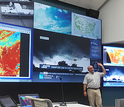
Research News
With launch of new National Water Model, advanced software and cyberinfrastructure help forecast flash floods with greater accuracy
August 24, 2016
The recent floods in Louisiana have reminded the nation of the devastation these disasters can cause, resulting in more than a dozen deaths and damaging more than 40,000 homes. David Maidment, a civil engineering researcher at The University of Texas at Austin, is acutely aware of the power and swiftness of floods — one that struck Nov. 1, 2013 still haunts him.
The storm started Halloween night. By the following morning, the wall of water that coursed through the city of Austin had swept away five residents, including a mother and her eight-month-old son.
The National Weather Service had issued a flash flood emergency warning for the area — the first one ever for Austin residents — but few expected the volume of water that came crashing down. The Blanco River, with only one forecast point downriver from where the major surge occurred, rose 11 feet in 15 minutes and peaked at 41 feet.
“People got killed without any capacity to respond,” said Maidment, a 2016 inductee into the National Academy of Engineering who works to mitigate flood risks around the country.
Not only does flooding cause extensive damage to hundreds of thousands of homes and businesses annually, but last year it killed more people than any other weather hazard, including tornadoes and hurricanes, with Texas experiencing the most flood-related deaths.
With support from NSF, Maidment and his team created a water model prototype for the science community for research purposes. That prototype helped establish the National Water Model, which launched on August 16 and now delivers forecast information, data, decision-support services and guidance to essential emergency services staff and water management personnel.
The National Water Model is operated by the Office of Water Prediction, a geographically distributed organization with locations in Maryland, Minnesota and Alabama. Established by the National Oceanic and Atmospheric Administration (NOAA) under its National Weather Service component, the Office of Water Prediction coordinates, integrates and supports consistent water prediction activities, from the global to the local level.
“Through our partnership with the research, academic and federal water community, NOAA is bringing the state-of-the-science in water forecasting and prediction to bear operationally,” said Thomas Graziano, NOAA’s director of the Office of Water Prediction, who holds a doctorate in atmospheric science.
The National Center for Atmospheric Research (NCAR), an NSF-sponsored center, developed the underlying technology for the model. NOAA then used that technology to develop and implemented the prototype along with NCAR, NSF, the Consortium of Universities for the Advancement of Hydrologic Science, Inc. (CUAHSI), and Integrated Water Resources Science and Services partners.
The model runs hourly simulations of current conditions. It also provides medium-range forecasts up to 10 days out and long-range forecasts up to 30 days out once per day.
Managing a deluge of data
The stream and river network of the continental United States consists of 2.7 million reaches. (A reach is a general term used to describe a length of stream or river surrounded by a local drainage area.) Until recently, agencies were only able to make flood forecasts on about 4,000 stream and river locations.
By combining geographic information system (GIS) data with real-time weather forecasts, and using sensor data from more than 8,000 U.S. Geological Survey gauges and other sources of information, the National Water Model can predict where dangerous flood situations will arise at all 2.7 million reaches in the United States.
To do so, however, requires powerful computers and software capable of stitching diverse pieces of information together and producing flow forecasts that can be quickly updated.
That’s where Maidment’s National Water Model prototype came in.
Testing prototype flood prediction systems
Collaborating with researchers at the NSF-supported CyberGIS Center for Advanced Digital and Spatial Studies at the University of Illinois at Urbana-Champaign, Maidment used the Stampede and Lonestar supercomputers at the Texas Advanced Computing Center (both funded by NSF) to manage the massive surge of data and to perform the necessary calculations to forecast events across regions and even nationwide.
During the NSF-funded National Flood Interoperability Experiment (NFIE), which the National Water Center and Consortium of Universities for the Advancement of Hydrologic Science conducted in June and July of 2015, Maidment demonstrated the feasibility of calculating the river flow for all 2.7 million stream reaches simultaneously.
Using the Stampede supercomputer in Texas, he was able to compute the streamflow for all output points in only 10 minutes.
“I have become a convert,” Maidment said. “When I proposed this effort, I had a good intuition that it could be accomplished. But the fact that we achieved it and can model the whole country is astounding. It’s lifted our expectations. We now have real-time hydrology for the whole nation.”
Daniel Katz, a former program director at NSF who oversaw the award to develop the water simulation software, emphasized the importance of Maidmen’s prototype outcome.
“This project is a great example of how integrated cyberinfrastructure — hardware, software, data, networks and people — can be used to solve some of the world’s most challenging problems and to positively impact people’s lives,” he said.
Earlier this summer, researchers at the CyberGIS Center went further, generating the first 10-meter resolution Height Above Nearest Drainage (HAND) model for the lower 48 states through a collaboration with the NFIE project. The HAND model normalizes diverse terrain according to the relative heights found along its drainage network, and in this way, more accurately determines the local draining potentials, an important factor for flood predictions.
The team also developed open source software on the CyberGIS platform that allows hydrologists to harness high-performance computing power to rapidly compute geographical and hydrological information for national flood predictions.
“The HAND model and computational workflow we developed provide unprecedented capabilities to conduct large-scale flood inundation mapping research,” said Yan Liu, technical coordinator at the University of Illinois at Urbana-Champaign’s CyberInfrastructure and Geospatial Information Laboratory. “It opens the door for GIS scientists and hydrologists to improve the national inundation mapping methodologies and achieve the goals of the National Flood Interoperability Experiment.”
Through the process of developing these proof of concept simulations, Maidment and his team made substantial contributions to the collective understanding of high-resolution hydrologic modeling on the continental scale, according to Edward Clark, director of the Geointelligence division at NOAA.
“This work aided the National Water Center in exploring key aspects of the modeling framework that are being transitioned into our operational supercomputing environment as the first instance of the National Water Model,” Clark said.
Maidment’s contributions included:
- Adapting the modeling framework to run on the supercomputers that are part of the Extreme Science and Engineering Discovery Environment (XSEDE).
- Prototyping pre-processing workflows and assessments of model input for real-time numerical weather prediction.
- Integrating the modeling output with the common geospatial framework, which provides a network representation of the rivers and streams across the continental U.S.
“In effect, water forecasting is becoming like weather forecasting with the National Water Model describing a continuum from the atmosphere to the oceans and from coast to coast through the stream and river network of the nation,” Maidment said.
At the White House Water Summit in March 2016, NOAA announced that the National Water Model will continuously forecast water flow on all of 2.7 million U.S. stream reaches — providing more than 700 times more detail than the previous model. With such a system now in place, Maidment and his collaborators hope they can reduce the damage of future flooding.
“We’ve lost a lot of people,” Maidment said, “and honestly some of them didn’t have to die.”
—
Aaron Dubrow,
National Science Foundation
(703) 292-4489 adubrow@nsf.gov
-
The National Water Model delivers flood forecast information to water management personnel.
Credit and Larger Version -
Streamflow anomaly guidance data from the National Water Model’s Image Viewer.
Credit and Larger Version -
The water cycle describes the continuous movement of water on, above and below the Earth’s surface.
Credit and Larger Version -
View VideoResearchers develop a suite of computational hydrology tools to aid in flood prediction.
Credit and Larger Version
Investigators
Alva Couch
Daniel Ames
Ethan Davis
Luc Anselin
Ray Idaszak
Shaowen Wang
Carole Palmer
E. Lynn Usery
Lawrence Band
Praveen Kumar
David Maidment
David Tarboton
Richard Hooper
David Valentine
Jennifer Arrigo
Timothy Nyerges
Jonathan Goodall
Katarzyna Keahey
Anand Padmanabhan
Budhendra Bhaduri
Robert Pennington
Venkatesh Merwade
Xiaohui Carol Song
Nancy Wilkins-Diehr
Related Institutions/Organizations
Utah State University
University of Texas at Austin
University of Illinois at Urbana-Champaign
University of North Carolina at Chapel Hill
Related Programs
Hydrologic Sciences (HS)
Software Infrastructure for Sustained Innovation – SSE & SSI
Related Awards
#1443080 CIF21 DIBBs: Scalable Capabilities for Spatial Data Synthesis
#1047916 SI2-SSI: CyberGIS Software Integration for Sustained Geospatial Innovation
#1343785 Title: EarthCube Building Blocks: Integrating Discrete and Continuous Data
#0413265 COLLABORATIVE RESEARCH: Development of Informatics Infrastructure for the Hydrologic Sciences
#1429699 MRI: Acquisition of a National CyberGIS Facility for Computing and Data-Intensive Geospatial Research and Education
#0622374 GeoInformatics: Consortium of Universities for the Advancement of Hydrologic Science, Inc (CUAHSI) Hydrologic Information Systems
#1148090 Collaborative Research: SI2-SSI: An Interactive Software Infrastructure for Sustaining Collaborative Community Innovation in the Hydrologic Sciences
#1148453 Collaborative Research: SI2-SSI: An Interactive Software Infrastructure for Sustaining Collaborative Community Innovation in the Hydrologic Sciences
Total Grants
$19,416,129
Related Agencies
NOAA
Related Websites
Office of Water Prediction: http://water.noaa.gov/
The National Water Model: http://water.noaa.gov/about/nwm
Consortium of Universities for the Advancement of Hydrologic Science, Inc. (CUAHSI): https://www.cuahsi.org/
Source: NSF News
Brought to you by China News













